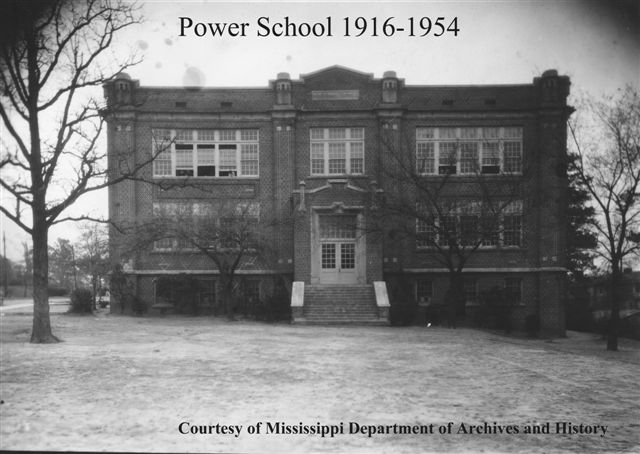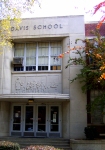This is the second in a series of articles on the Belhaven neighborhood by Bill and Nan Harvey supplemented by links to more detailed stories published earlier in Jesse Yancy’s Mississippi Sideboard. In this part we discuss the first developments in the neighborhood which include early homes, residents, streets and institutions.
The area that became the Belhaven neighborhood began around 1900 with small residential developments along North State Street. Gradually the growth pattern spread north and east as open land was subdivided and homes constructed. More than 20 subdivisions were platted north of Fortification to the future Riverside Drive and east of State Street to the modern day I-55.
The first subdivision in the district, the North Park Addition platted on April 17, 1900 by owners George W. Carlisle, et. al., included the southwest corner of what was to become the Belhaven neighborhood east from North State to Kenwood and north from Fortification to Poplar. Today only a small portion east of Jefferson Street remains in the Belhaven Historic District. The next subdivision, North Belleview, which platted in January 1905 by Hollingsworth and Magruder, is a rectangular subdivision north of present day Belhaven Street to Euclid and east to Edgewood to Peachtree.
Additional information on Belhaven development can be obtained from Hinds County plat maps and the narrative application by the Greater Belhaven Neighborhood Foundation to the U.S. Department of Interior National Park Service for the designation of the Belhaven area as a historic district.

The Fairview, a colonial revival mansion, built in 1908 by Cyrus Warren, a local lumberman, now serves as a bread and breakfast inn owned and operated by Peter and Tamar Sharp. It was for many years the home of the D.C. Simmons family and is listed on the National Register of Historic Places

Early in the 20th century Rev. Bryan Simmons, a Baptist minister, told of a fight that occurred in Jackson near the Illinois Central Railroad depot on Capitol Street. One of the combatants was shot and critically wounded. Among those who came to the scene was a young doctor with a small local practice established in 1905. His name was Harley Roseborough Shands. Dr. Shands realized emergency surgery was necessary. Since there was no local hospital in which to take him Dr. Shands successfully treated the gunshot victim at his small office on Capitol Street. Dr. Shands brought the first microscope to Jackson used in a medical practice.
In September 1905, another doctor reported a case in south Jackson that he thought might be yellow fever. Crowds gathered on Capitol Street to await the verdict of Dr. Shands’ microscope. When the words came “No yellow fever”, the crowds cheered and “there was much handshaking, backslapping, laughter and rejoicing.” Dr. Shands knew of another Tulane medical graduate whose father had served for many years as pastor of Jackson’s First Presbyterian Church. This older physician was Dr. John Farrar Hunter who in addition to practicing medicine operated the J.F. Hunter & Company drug store at the corner of Capitol and State Streets. Recognizing the need for more professional medical care in the city, the two doctors established the Hunter and Shands clinic in 1907.

It was obvious that Jackson needed a larger facility for treating the critically ill. The realization of this need was shared by the Rev. W.F. Yarbrough, pastor of the first Baptist Church who had come to visit a patient in the Hunter and Shands Clinic. Through Rev. Yarborough, doctors Shands and Hunter offered their small facility to the Mississippi Baptists after several other denominations had turned it down. At a meeting of the Mississippi Baptist Convention in the fall of 1909, Rev, Yarbrough offered a resolution that the Convention “look with favor on the offer of property valued at $5,000 in the City of Jackson for hospital purposes and that a committee be appointed to study the proposal.” Drs. Hunter and Shands offered their property as a gift with only their $5,000 in equipment investment to be compensated. On December 16, 1910 the hospital committee met with the two physicians and accepted its offer which was finalized in a letter dated October 12, 1910. The committee took charge on January 1, 1911 and the Mississippi Baptist Hospital came into being.
As Christian evangelist Robert H. Schuller (1926-2015), once said, “Today’s accomplishments were yesterday’s impossibilities.” One of yesterday’s impossibilities became today’s Mississippi Baptist Medical Center. Through the vision, generosity and determination of three early Jackson citizens the city’s first real hospital was established in our neighborhood a little over 100 years ago. It was Belhaven’s first great institution and a significant modern supporter of our fine neighborhood foundation.
Jackson’s expansion north and eastward continued sporadically through the teens and early twenties of the 20th century. Many of the newer streets were outside the city and bore different names than those we know today. Early streets were named by developers, prominent citizens or for families who owned land along their borders. Sanborn Fire Insurance Company maps of the period give us a window to view where we might have lived when the neighborhood was young.
There were streets and avenues and places and circles some at different times on a single thoroughfare. Original street names often changed when brought into the city or when someone realized there were duplications that could be confusing. For example, at one time in 1925 there were three Park Avenues. State Street, named for that “great street” in Chicago, has always borne that name but some of its intersecting street names would not be recognizable today. Poplar Boulevard from State to Kenwood was Wells Street, Pinehurst Place was Harper, Fairview, named for Mr. Warren’s home, went only to Edgewood and the eastern two blocks were Morehead Ave. Oakwood was Mims Place. As you move eastward Kenwood was one of those Parks, as was Edgewood and a portion of Peachtree. Greymont was Sullivan Street, Linden Place from Poplar to Pinehurst was Opper (Upper?) Drive, Pine was Jefferson extended, the first block of Marshall was Taylor, portions of Manship were Persimmon, Laurel was Willow and Riverside was the Pumphouse Road.
Belhaven Street was not one of the earliest streets entering State but was constructed shortly after the college relocated to Peachtree in 1911. Rose Hill was originally designed to be a circle. It was to be bisected by Springbrook and once entered St. Ann between the 1100 and 1200 blocks. It was never fully built as the railroad reneged on its agreement to deed the land to the city and Rose Hill’s circle was never completed.
Riverside Drive did not come into the city until 1930, but prior to that was known as the Pumphouse Road. According to Belhaven resident Muller Addkison, the gravel road followed Riverside’s overlay but turned and extended southward from the water plant along the Pearl River and on to Devil’s Elbow beach. A few cars, horses and foot traffic could be seen on a Sunday afternoon along the riverside and young men would take the College girls riding along the banks. Annual floods, a new highway and time itself took out the road and left just the river and a few bankside fishermen as monuments to its existence. It’s gone now, a victim of progress.
A development that stood out was Gillespie Place, particularly its first block off State Street. Gillespie Place marked the southern end of the Gillespie Farm which consisted of land purchased shortly after the Civil War by Capt. William Marion Gillaspie (Gillespie) (1823-1893). Capt. Gillespie came to the Jackson area from Purdy County, Tennessee. He was a school teacher, had knowledge of pharmacy and was associated with Planters Insurance Company.
Captain Gillespie purchased 40 acres of meadows and woods for $840 which became the Gillespie Farm. His home near State Street was secluded in a wooded area where only the gables could be seen from the road. The rough outline of this property today would start at Gillespie Place, run north to Arlington and east to the center of today’s 700 blocks. Mrs. Charlotte Charles said that the eastern terminus of the farm was her house and lot at 762 Gillespie.
After the Captain’s death the old Gillespie Place home burned. It is said that the he left a fortune in silver buried on the grounds of his homestead and thus the land became the target of a number of treasure hunters bearing shovels and harboring high hopes. But that is just a legend and by definition a legend is interesting and historical but not verifiable. Or is it?
The Gillespie Farm was subdivided into lots and sold with the first home at 749 Gillespie Place built in 1910 (Carnahan House). 
In 1916 Jackson had seven elementary schools. These were Poindexter on Robinson (Jackson’s first elementary school), George on Roach St. (Duttoville school), Poindexter on W. Capitol, Davis on N. Congress, Galloway on Bailey Ave., Jim Hill on Lynch St. and Smith Robertson on Bloom St. There was no school north of Fortification and east of State to serve Jackson’s fastest growing neighborhood.
According to Department of Education board minutes for August 21, 1916, a resolution was passed naming the new school at the corner of N. State and Pinehurst Place for Col. J.L. Power (1834-1901). While not a school man, Col. Power served on several boards and committees that provided administration to Jackson’s early school system. Col. Power distinguished himself in the 1st Artillery Regiment, Company A of the Confederate Army. After the war he worked in the publishing business and helped establish the Mississippi Standard which later merged with the Clarion Ledger. For 27 years he was superintendent of the First Presbyterian Sunday School and was a ruling elder in that church. He was Grand Secretary of all Mississippi Masons from 1869 until his death.

Over the next 30 years the first Power School suffered from a problem many of us in our neighborhood endure today – Yazoo clay. The building became unstable in the early 1950’s and was closed in 1954. However, a new Power School was being constructed at 1120 Riverside Drive and today serves as an incubator for some of Jackson’s most gifted students.
Belhaven College endured many struggles in its early years just to survive. We have mentioned its beginnings with the acquisition of Col. Jones Hamilton’s property by Dr. Louis Fitzhugh in 1894 and its destruction by fire the following year. The school was rebuilt on the same grounds and Mrs. J.R. Preston, wife of its second president, remembers in a mid-20th century address details of the first campus in Belhaven Heights.
“It comes vividly before me, the grounds of ten acres, most of which was in the campus, the rest in pasture for Jersey cows where in the spring they stood knee deep in clover. I can still see the campus naturally adorned with the native trees, oak, elm, hackberry and a few magnolias with a row of pink crepe myrtle for the southern boundary. Still to be seen from the south as one drives down Belleview (now Bellevue), were the rockeries (rock gardens) adding a formal touch and there was a basketball field nearby. A quaint landmark was the style by which pedestrians gained access to the board walk leading directly to the dormitory. This climb by day was breath-taking and by night more than spooky.”
A second devastating fire destroyed the school in October 1910 and the Boyd (Belleview) site was abandoned. Construction began immediately on today’s present Peachtree campus on and the school was renamed the Belhaven Collegiate and Industrial Institute on July 25, 1911.
We come now to the end of Belhaven’s early years, years of innovation, growth and a pioneering spirit. There is little doubt that our neighborhood would prosper and continue its progress toward a special place in our city. Our next section, the middle years, will continue this progress. There will be a seasoning of our namesake college, the state’s first air conditioned supermarket, the little filling station that became a refuge, the day a king came to visit, a subdivision within a subdivision, a new park, our most famous resident and much more. Two events occurred in 1925 that would set this stage: the city limits were expanded northward to Euclid and eastward to Peachtree and C.W. Welty would sell his home on N. Congress and move his family to 1119 Pinehurst. Mr. Welty had a 16-year-old daughter named Eudora.







